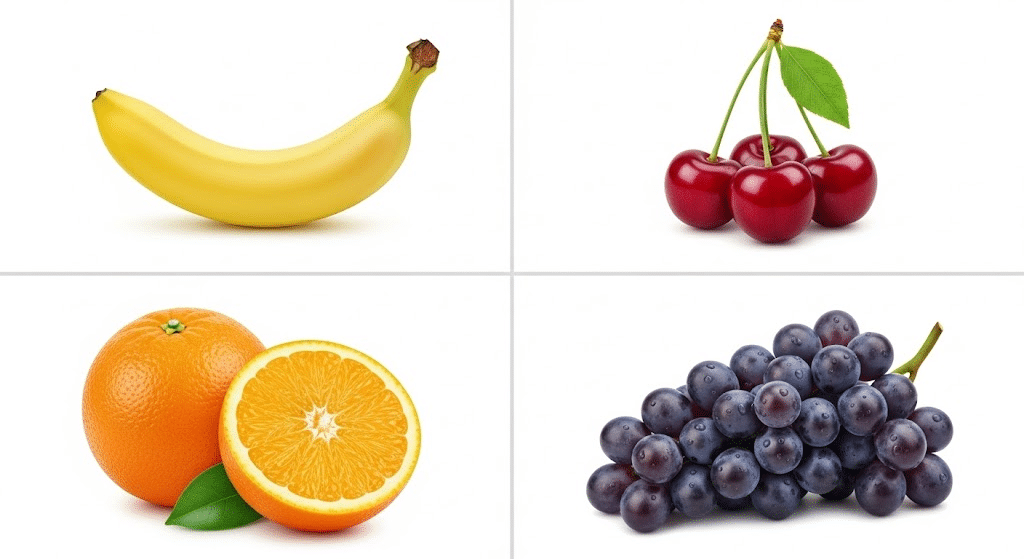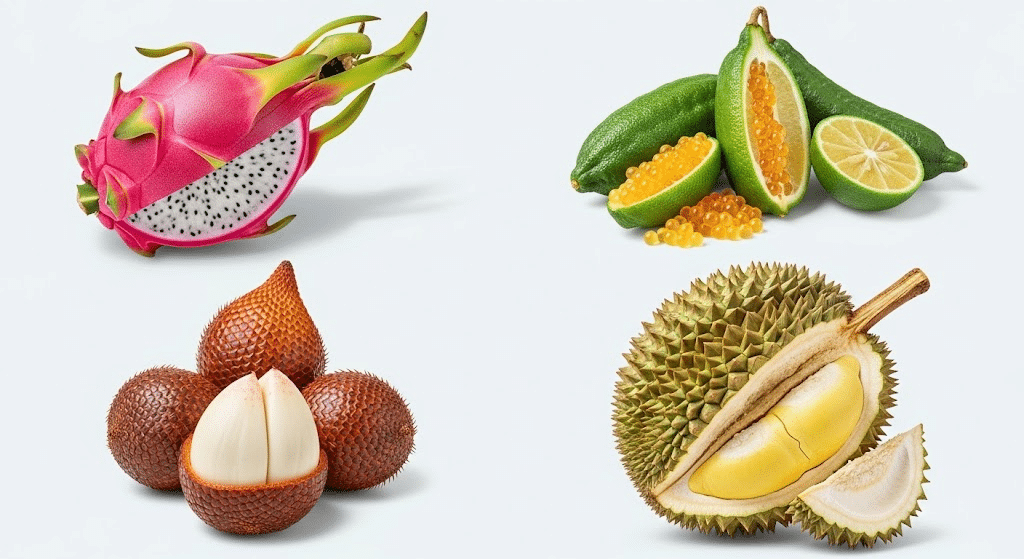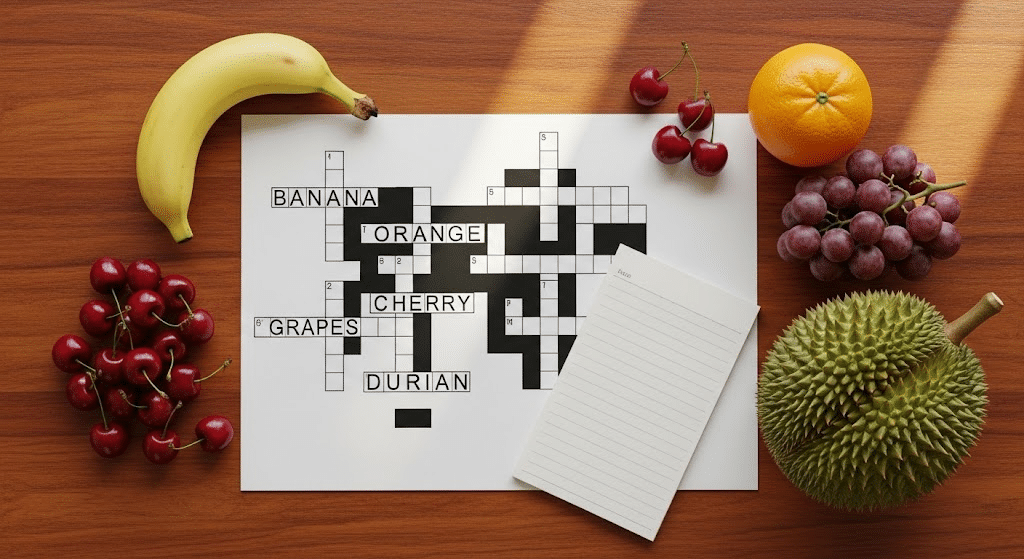Ever noticed how some fruits seem perfect for word games and puzzles? 6 letter fruits hold a special place in crosswords, trivia nights, and vocabulary building.
These fruits offer more than just their delicious taste; they’re linguistic gems that help expand our knowledge while providing fun facts to share with friends.
This blog will help you master six-letter fruits for crossword success, boost your fruit vocabulary, and impress others with interesting trivia.
Ready to become a six-letter fruit expert? Let’s check out these interesting fruits that bridge the gap between nutrition and wordplay.
Why Focus on 6 Letter Fruits?
Six letters hit the perfect sweet spot. Not too short like “fig,” not too long like “watermelon.” Just right.
Words like “orange” and “cherry” roll off your tongue easily. Our brains remember six-letter combinations better than other lengths – that’s why successful brands often use exactly six letters. Kids learning to read love these words because they look manageable but important.
Word game players know the secret too. 6 letter fruits score well in Scrabble and fit perfectly in crossword puzzles. “Papaya” and “mango” show up constantly for good reason.
Practically speaking, six letters work everywhere. They fit on produce stickers, look balanced on menus, and don’t overwhelm text messages.
For English learners, they offer the perfect challenge level – familiar but not boring.
Six-letter fruits represent that ideal balance of common and interesting. Sometimes the most fascinating things hide in plain sight.
List of 6 letter fruits
Fruits come in all shapes, sizes, and flavors, but some stand out not only for their taste but also for their unique characteristics and cultural significance.
In this curated list, we will look at 6 letter fruits both common favorites and exotic treasures that offer a delightful mix of nutrition.
Common Fruits

Common fruits are beloved staples enjoyed worldwide for their sweet flavors, nutritional benefits, and versatility. From bananas to cherries, these fruits nourish the body and delight the taste buds every day.
1. Banana
This yellow curved fruit provides instant energy and potassium. Bananas are technically berries, and they grow upward toward the sun. Americans eat more bananas than apples and oranges combined.
2. Cherry
Sweet or tart red fruits that grow on trees in clusters. Cherries contain melatonin, which helps regulate sleep cycles. A single cherry tree can produce up to 7,000 cherries in one season.
3. Orange
Citrus fruit is packed with vitamin C and has a bright flavor. Oranges were originally green in tropical climates. The color orange was named after the fruit, not the other way around.
4. Grapes
Small, round fruits that grow in bunches on vines. Grapes have been cultivated for over 8,000 years. There are over 10,000 grape varieties worldwide, but only about 1,300 are used for wine.
5. Papaya
Tropical orange fruit with black seeds and sweet flesh. Papayas contain enzymes that help digest protein. Christopher Columbus called papayas “the fruit of angels” because of their sweet taste.
6. Melons
Sweet, juicy fruits with high water content and soft flesh. Melons are 90% water, making them perfect for hot weather. Ancient Egyptians placed melons in burial tombs to nourish the dead.
7. Tomato
Red fruit botanically classified as a berry, commonly used as vegetable. Tomatoes were once thought to be poisonous in Europe. The largest tomato ever grown weighed over 10 pounds.
8. Lychee
Pink-shelled tropical fruit with translucent white flesh inside. Lychees have been called “the king of fruits” in some Asian cultures. They’re related to rambutan and longan fruits.
9. Raisin
Dried grapes that become sweet and chewy when dehydrated. Raisins were first made accidentally when grapes dried on the vine. California produces 99% of America’s raisin supply.
10. Damson
Small purple plums with tart flavor, perfect for jams. Damsons are named after Damascus, where they supposedly originated. These hardy fruits can survive harsh winter conditions better than regular plums.
11. Prunes
Dried plums known for their digestive benefits and wrinkled appearance. Prunes are now marketed as “dried plums” to improve sales. They contain more antioxidants than fresh plums.
12. Bignay
Bignay (Antidesma bunius) is a small, round, red-to-purple fruit with a sweet-tart flavor. Rich in vitamin C and antioxidants, it supports immunity, digestion, and heart health. Used fresh, in jams, wine, and teas.
Exotic Fruits

These fruits are not native to many areas but are cultivated globally, appreciated for their rich nutritional content, including vitamins, minerals, and antioxidants that promote health
13. Durian
Spiky Southeast Asian fruit famous for its strong smell. Durian is banned from many hotels and public transport due to its odor. Despite the smell, it tastes creamy and sweet.
14. Feijoa
Green egg-shaped fruit with aromatic flesh and edible skin. Feijoas taste like a mix of pineapple, apple, and mint. They’re also called pineapple guavas despite not being related to either fruit.
15. Longan
Small round fruit with translucent flesh and brown shell. Longan means “dragon eye” in Chinese due to its appearance. It’s closely related to lychee but has a different flavor profile.
16. Medlar
Brown fruit that must rot slightly before becoming edible. Medlars were popular in medieval times but are rare today. They taste like spiced apple sauce when properly ripened.
17. Santol
Santol is a tropical fruit with sweet and tangy pulp, rich in vitamin C, calcium, and iron. It aids immunity, digestion, and skin health, but its seeds are inedible and toxic
18. Babaco
Yellow star-shaped fruit from Ecuador with no seeds. Babaco is called “champagne fruit” due to its effervescent quality. It can be eaten raw or cooked and tastes like papaya mixed with strawberry.
19. Canari
Bright yellow melon-like fruit from French Polynesia. Canari melons have orange flesh and a sweet, tropical flavor. They’re often used in fruit salads and desserts in the Pacific islands.
20. Pawpaw
North American fruit that tastes like banana and mango combined. Pawpaws are the largest native fruit in the United States. They’re also called “prairie banana” or “poor man’s banana.”
21. Ackees
The national fruit of Jamaica is with yellow-red pods and white flesh. Ackees must be fully ripe before eating as unripe ones are toxic. They’re traditionally cooked with saltfish in Jamaican cuisine.
Tips for Crossword Puzzle Success
- Start with crossing words first to get letter hints before tackling the fruit clue directly. Even one or two confirmed letters can narrow down your options significantly and point you toward the right six-letter fruit answer.
- Pay attention to the clue wording for hints about plural forms. Words like “bunch” or “several” often indicate plural fruits like “grapes” or “apples” rather than singular forms, helping you choose the correct spelling variation.
- Use the vowel-consonant pattern to your advantage when stuck. Most six-letter fruits follow predictable patterns like consonant-vowel-consonant-consonant-vowel-consonant, which can guide your letter placement even with limited crossing letters.
- Consider seasonal or regional clues that might hint at specific fruits. Summer-themed puzzles often feature “grapes” or “cherry,” while tropical clues might point toward “papaya” or “mango” as the intended answer.
- Keep a mental list of the most common six-letter fruits that appear in puzzles. “Orange,” “banana,” “grapes,” “apples,” and “cherry” show up repeatedly, so having these ready in your memory speeds up solving time considerably.
Final Thoughts
Letter fruits prove that good things come in perfectly sized packages. To add variety to daily meals, these fruits offer benefits that extend far beyond their taste.
So what’s the next step? Start incorporating these fruits into your routine. Try a new six-letter fruit this week, whether it’s adding grapes to your salad or using lemons in your cooking.
Keep this knowledge handy for your next crossword puzzle, too.
Which six-letter fruit will you try first? Share your experiences and let others know how these tips worked for you. Your fruit knowledge just got a whole lot more interesting.


















